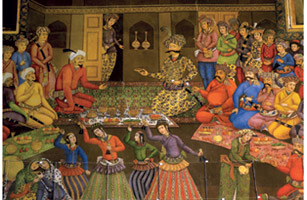
When western diplomats seek concessions from Iran, they typically dish out tough rhetoric and threaten sanctions. Neil MacGregor, the cherub-faced director of the British Museum, uses a more refined arsenal: cultural relics and priceless artifacts. In January, MacGregor traveled to Tehran to finalize the loan of treasures from eight of Iran’s best museums. In exchange, he promised to loan the National Museum of Iran the Cyrus Cylinder, a 2,500-year-old clay cylinder inscribed with decrees from the Persian emperor Cyrus the Great. Following a request by the Iranian Vice President’s office, he also vowed to raise international awareness of damage done to archaeological sites in Gaza during Israel’s recent military operation. The lofty maneuvering paid off: three weeks later, dozens of crates containing Persian rugs and 17th century mosque ornaments were winging their way to London.
At a time when more conventional channels of communication between Britain and Iran have stalled, MacGregor’s cultural diplomacy is opening up another avenue for dialogue. The British Museum, especially since MacGregor took the helm in 2002, has used traveling exhibitions and curatorial exchanges to successfully engage museums from China to North Korea to Sudan. “The more difficult the political relations are, the more important it is to try to understand the history of the country with whom we’re having difficult conversations,” he says.
With “Shah ‘Abbas: The Remaking of Iran” the British Museum seeks to break down the perception of Iran as a hostile state on the fringe — politically and culturally — of the modern world. The exhibition, which runs until June 14, brings together an astonishing collection of Persian artifacts, many of which have never been seen together inside Iran, let alone outside the country. The show highlights the accomplishments of Shah ‘Abbas, who ruled Persia from 1587 to 1629, ushering in a golden age for arts and culture, and opening the country to European trade. Says MacGregor: “He created a multi-faith society in touch with the rest of the world. That’s why now he is someone really worth thinking about.”
Given recent events, that’s an understatement. On Feb. 3, one day after Iran launched its first domestically produced satellite, Britain’s Foreign Office condemned the move, saying it raised “serious concerns about Iran’s intentions.” Two days later, the British Council, a body that promotes international cultural dialogue, suspended its operations in Tehran citing “intimidation” of its staff by Iranian officials. But the organizers of the Shah ‘Abbas show were unperturbed. Curator Sheila Canby says the spirit of inquiry that museums share helps them transcend political tensions. “We’ve been told by Iranian and British officials that this is just the kind of exchange that should happen,” she says. “No matter what else happens, this is a benign and informative way to exchange ideas.”
That may be true, but officials at the British Museum speak from a privileged position. They don’t answer to the government and can freely pursue a cultural agenda with any country. For Iran’s curators, politics underscores every exchange, and sending relics abroad requires authorization from some of Iran’s most powerful bureaucrats. That makes the Shah ‘Abbas show all the more significant. “Iranians feel they are misunderstood, misrepresented and sometimes rather snubbed by the West,” says Michael Axworthy, director of the Centre for Persian and Iranian Studies at the University of Exeter. “There are few things the Iranians look for more than an appreciation for where they are coming from culturally and intellectually.”
The Iran on show is a far cry from the clichd picture of an angry, anti-U.S. Islamic state with a Holocaust-denying President. Under Shah ‘Abbas, Iran became a center of diplomacy and trade. Glorious paintings from the early 17th century depict British envoys who traded gold and silver for silk rugs; other prints capture negotiations in which Iranians mingle with Uzbeks and Indians. Like his contemporary Elizabeth I, Shah ‘Abbas waged war to defend his nation’s territory. But unlike England, MacGregor says, the Shah’s Iran “accommodated other faiths,” as seen by gospels beautifully illustrated by Armenian Christians who were forcibly resettled in Iran from 1603.
See pictures of the rise and fall of the Shah of Iran.